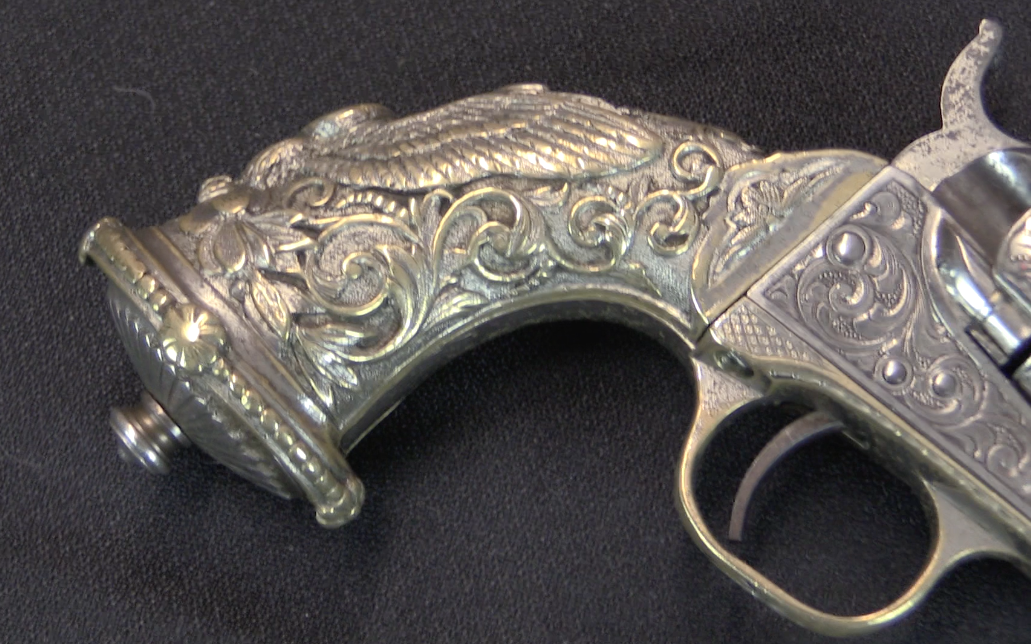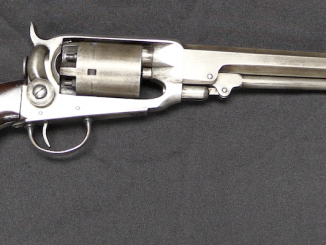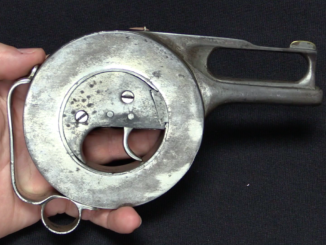These Ingram SMGs are selling in the April 2019 Morphy’s auction:
M10/45 (lot 1069), M10/9 (lot 1070), and M11 (lot 1067)
After the commercial failure of Gordon Ingram’s M6 submachine gun in the early 50s, we would radically change the layout of his designs. Instead of a Thompson lookalike Ingram’s M10 (the M7, M8, and M9 doing experimental prototypes only) would be a boxy and compact affair with a Czech-style telescoping bolt. It found little interest until a meeting between Gordon Ingram and Mitch WerBell resulted in WerBell demonstrating it to excited military audiences in Vietnam in 1969.
WebBell was an ex-OSS man who had started a company called Sionics, selling suppressors to the US military. He thought the combination of Ingrams submachine gun and his suppressor would be a fantastic package, and he found plenty of interest in special operations personnel in Vietnam. He would create the Military Armament Corporation based at his farm in Powder Springs, GA and entice Ingram to join as his chief engineer. The result would be the .45ACP M10, a 9mm version of the M10 (made for use with subsonic 9mm ammunition), and a scaled-down .380 ACP M11 submachine gun.
MAC would have a short life, with all its assets sold at a bankruptcy auction in April 1976 – but it had plenty of time to create what would become an iconic gun – the Big MAC. Many imitations and copies would follow, but Powder Springs was the home of true original Ingram M10 and M11 submachine guns!




Wait, WerBell or WebBell? Also is uppercase letter inside his name intended or just typing error?
Ian,
I want to sell a Cobray original Mac-10 magazine. Double feed, 9mm, 32 round. Please contact me.
Oscar
ameen.amg433@gmail.com how feasible
How’s it going I’m looking to purchase a Mac 10 do you still have it???
Hi, you can check here
Can I see pictures
I own two of these Ingram’s. And live near Powder Springs, GA. Pass the WerBell property daily. It’s currently for sale. They are quite collectable these days. In their heyday the guns were cheap and parts and mags were all over the place – but not now. What little original out there has gotten expensive. I keep them as collectables only – because they are in fact one of the worst SMG’s ever made. Heavy, ungainly, a sorry stock and grip design, and a way too high rate of fire.
Useful comment, it is appreciated.
You forgot “…and hideously inaccurate.”
I can remember trying for at least a reasonably tightish classic ‘group o’ six’ at about 1en yards and found while indeed it was possible …but only if your definition of a ten-yard group was about 1 meter in diameter.
And for your further consideration, I also have a half-century-old possibly (likely) memory of at least one temp issue of an anonymous unstamped (no data at all) M12 in .32 ACP. Yes, you read it right.. .ACP.
Conjecture at the time was as an intent for possible issue in Eastern Europe or China, should political stability become a thing of the past. Happily that was not to be, but I wouldn’t mind hearing anybody knowing anyone with hands-on experience with an M12 in .32ACP.
Another excellent explanation by Ian; very enlightening. Also, as he aptly points out, these weapons were of limited utility. This is where miniaturisation went to an extreme. In contract the Uzi and HK SMGs have apparently more practical usability.
“In contract …” was intended to be “in CONTRAST”.
“Uzi(…)have apparently more practical usability”
Nonetheless Israelis developed also Micro UZI:
https://modernfirearms.net/en/submachine-guns/israel-submachine-guns/uzi-micro-uzi-mini-uzi-eng/
firing 9×19 Parabellum and even lighter than M11 (1,5 kg vs 1,59 kg) but of similar size and Rate-of-Fire (1250 rpm vs 1200 rpm), so they saw enough need for such kind of weapon to warrant development.
So does the US Army and buys 350-1000 really small B&T APC9k for bodyguards.
https://www.fbo.gov/index?s=opportunity&mode=form&id=e001bfaf6f293d0401029cd8052312ec&tab=core&_cview=0
When you need something for the phone booth. 😉
Russians also have developed “small sub-machine gun” (in 1990s), see:
https://guns.fandom.com/wiki/OTs-22_Buk
More of a gimmick in my opinion !
Uzi got its fame and status from original full size UZI.
If they developed a rate reducer, like Skorpion, that could be usable
Contact me
‘In contact’ would have made sense too.
Am I correct to assume these are actually a double stamp weapon? F/A and suppressor.
The suppressor wasn’t integral, and wasn’t included with every gun — two wholly separate NFA “firearm” purchases that happened to work together. IIRC, most MACs were sold without teh suppressor (despite that being the best way to fire one, if only because it enhances controllability tremendously)
Thank,I thought they came with the suppressors.
Apologies in advance if Ian has covered this, I haven’t seen the vid.
‘fraid I’m on a terrible mobile connection, and having to use a VPN to even get FW to load
Didn’t the M10 have a lead filled bolt to reduce the rate of fire within the limited size of the receiver and bolt?
Memories of reading Truby’s books on moderators when I was in my late teens. He had quite a lot of space devoted to Mitch WerBell (a self described “exceptionally quiet American”). IIRC, the sionics suppressor was overly complicated to make, with a spiral baffle after a wire mesh filled expansion (and heat sink) chamber.
I got an old copy of the reprint of united state tests on moderators, from a second hand bookshop in Harrogate
Apparently the book had been in Rhodesia during the Smithy UDI years.
There had been some other gunny books in the shop, but someone had snitched and the local cops had stolen them; “You don’t want these, do you (said with the intonation of an ominous threat, rather than a question)”.
Anyway, about the most effective moderator tested was the original, asymmetric Maxim moderator.
There is a bit of recoil (and climb) reduction from a moderator, both due to additional weight up front and due to the reduced jet reaction from the muzzle blast.
“There is a bit of recoil (and climb) reduction from a moderator, both due to additional weight up front and due to the reduced jet reaction from the muzzle blast.”
Did anybody equip MAC 10 (or derivative) in muzzle brake? It should be shorter than moderator and possibly more effective in recoil damping?
Actually, it was mostly a cost-cutting effort. Instead of machining a bolt from bar stock, the Ingram MAC design used one cut from sheet steel and folded into shape like a cardboard box,spot-welded at the corners, and then poured full of liquified lead to provide the mass and solidity to function correctly.
It was actually only a bit heavier than a comparable machined-steel bolt, not enough to have much effect on RoF.
My experience with MAC-10s was mostly with the .45 ACP version. It was definitely more controllable with the suppressor attached, and since .45 ACP is subsonic unlike standard 9 x 19mm, it was actually moderately quiet.
cheers
eon
“Eight and three-quarter pounds”?
Really?
I have briefly used the M10, and reckoned it was more like six and a bit. Which is also what published sources suggest. .
I am curious about the differences in the bolt and chamber/feed-ramp? between the m10 in .45aCP and 9MM Parabellum to handle double-feed (9mm) vs single-feed (.45)
I used the .45 cal M10 operationally on a limited scale and I loved it. I found the weight of the weapon did a fine job of absorbing that .45 cal recoil. The firing rate I admit did require a good bit of practice to tame as this weapon DEMANDS trigger control. Once I learned to pull it in tight the stock was no longer an issue. All in all I found it a wonderful weapon altho it had a fairly steep learning curve.
[OFF-TOPIC so ignore if you wish]
Winner of Sub Compact Weapon competition is B&T according to:
https://www.thefirearmblog.com/blog/2019/04/01/breaking-us-army-selects-bt-for-new-sub-compact-weapon/
what is quite mind-boggling for me that barrel no longer than 5.5 inches was required, where most often minimal length is specified, not maximal. Looks either as caused by wanting of usage sub-sonic ammunition, so barrel should not be too long as it would increase speed or either indirect saying that they want magazine forward of grip rather than inside.
It was entirely because they wanted to get guns that were as concealable as possible, while still meeting the accuracy and controllability requirements. The overall length of the gun, with any stock folded or collapsed fully, would not be any different between “mag in grip” versus “mag forward of grip”, presuming similar stock designs. And the controllability and ergonomics are greatly improved when not forced to work around a 90 degree angled grip fat enough for a truly reliable SMG magazine.
It may sounds cynical, but what was the favor asked to Switzerland for granting contracts to Swiss companies?
In my copy of “Military Small Arms of the 20th Century” by Ian Hogg and John Weeks, it says that the charging handle of the Ingrams M10 could be rotated to make the gun safe, but that would appear not to be so.
With respect to the Ingrams M6, they also state that a short trigger pull fires single shots, and a long pull produces full auto. Again, that appears not to be the case, and the M6 is full auto only.
It just goes to show that you cannot necessarily trust even well regarded written sources.
Hogg’s stuff tended to be too broad brush
He was small arms editor or authour for Janes
And his popular stuff tends to be written/ compiled to a coffee table standard.
Guns are one of the many areas that benefit from a slow writing approach.
Ian (in my totally biased opinion) seems to hit the right balance between depth of coverage and volume of output. So do Othias and Mae. They’re all exceptions.
– I bet that they don’t make nearly as much money as they would if they wrote at a standard appropriate for the hard of thinking, but they do stay true to their principles.
On the original M-10’s the charging handle could indeed be rotated 90 degrees to lock the bolt in the forward position.
“Lear jet S.W.A.T team
On a midnight run
With the M16
And the Ingram gun”
–Warren Zevon, “Jungle Work”
Suppressor shown is not original, but has been re-cored (looks like a Bowers). WerBells original SIONICS suppressor design used a surplus boot-eyelet packing (strangely) in the first stage and a pair of opposite spiral diffusors in the second stage, with a few neoprene wipes thrown in.
I’d forgotten about the wipes.
They’re an abysmal feature.
They destroy accuracy and Wear out fast.
Don’t forget the old gag of sticking a wad of wet chewing gum over the suppressor muzzle to cut down the precursor wave.
cheers
eon
But first you need to spray moskeeto repellent inside 😉
Didn’t the CIA use these? I know people are saying they weren’t very good but it would certainly clear a room of bad guys?
I know something about RPB
Need a m 10 barrel and bolt? Anyone